Project Negotiation Methods and Outcomes
VerifiedAdded on 2021/04/19
|7
|2051
|36
AI Summary
The provided assignment discusses the negotiation methods and outcomes for four distinct projects: Project 1 (Forward Strategy for Payroll System), Project 2 (Governance and Decision-Making), Project 3 (People and Change), and Project 4 (Funding). It recommends specific negotiation approaches ('Distributive Negotiation', 'Integrated Negotiation', 'Staged Negotiation', and 'Integrative Negotiation') and procurement outcomes (Request for Proposals, Two Staged Tendering, Single Source Tendering, and Restricted Tendering) for each project. The document is likely a solved assignment or past paper meant to assist students in understanding project negotiation strategies.
Contribute Materials
Your contribution can guide someone’s learning journey. Share your
documents today.
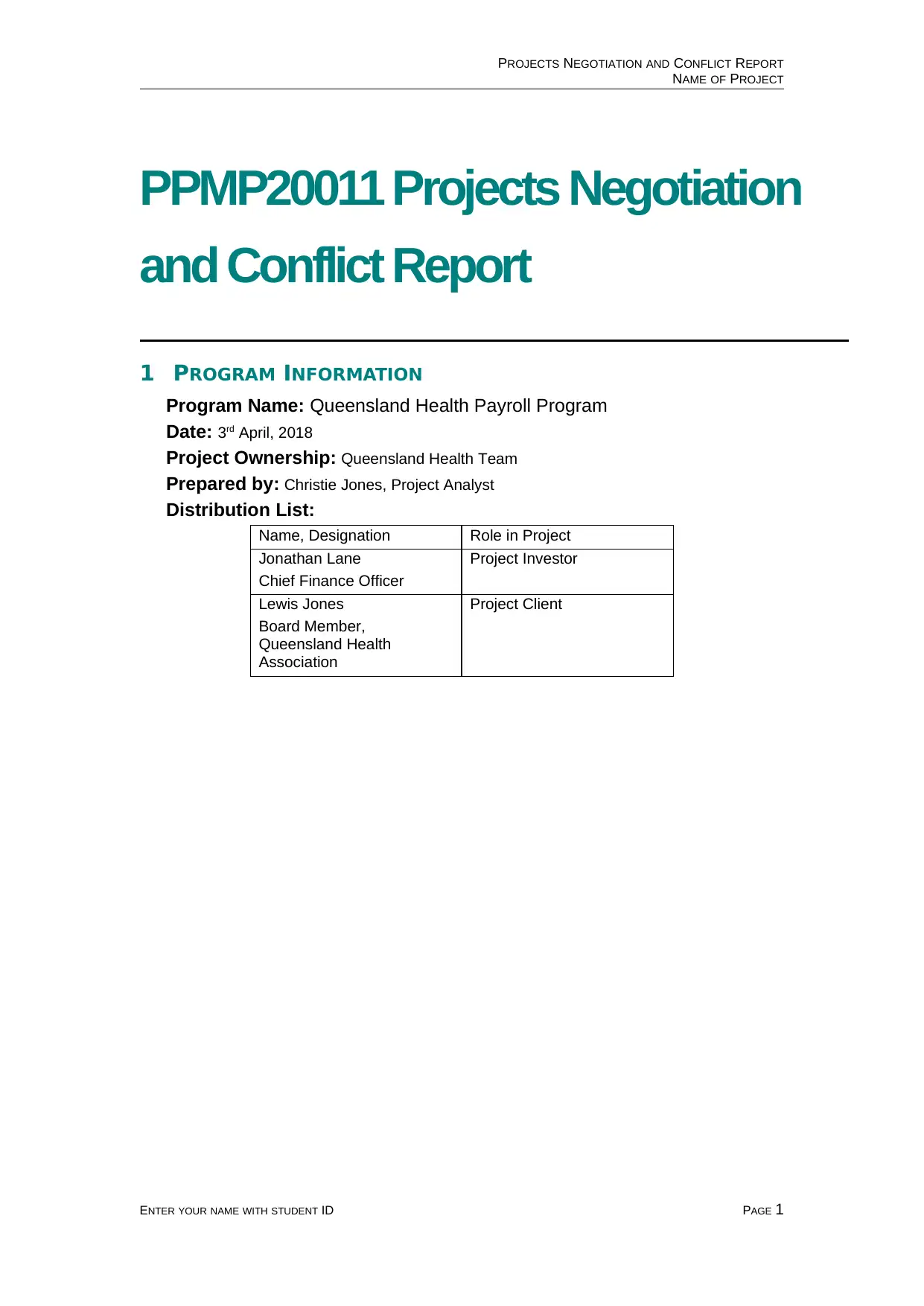
PROJECTS NEGOTIATION AND CONFLICT REPORT
NAME OF PROJECT
PPMP20011 Projects Negotiation
and Conflict Report
1 PROGRAM INFORMATION
Program Name: Queensland Health Payroll Program
Date: 3rd April, 2018
Project Ownership: Queensland Health Team
Prepared by: Christie Jones, Project Analyst
Distribution List:
Name, Designation Role in Project
Jonathan Lane
Chief Finance Officer
Project Investor
Lewis Jones
Board Member,
Queensland Health
Association
Project Client
ENTER YOUR NAME WITH STUDENT ID PAGE 1
NAME OF PROJECT
PPMP20011 Projects Negotiation
and Conflict Report
1 PROGRAM INFORMATION
Program Name: Queensland Health Payroll Program
Date: 3rd April, 2018
Project Ownership: Queensland Health Team
Prepared by: Christie Jones, Project Analyst
Distribution List:
Name, Designation Role in Project
Jonathan Lane
Chief Finance Officer
Project Investor
Lewis Jones
Board Member,
Queensland Health
Association
Project Client
ENTER YOUR NAME WITH STUDENT ID PAGE 1
Secure Best Marks with AI Grader
Need help grading? Try our AI Grader for instant feedback on your assignments.
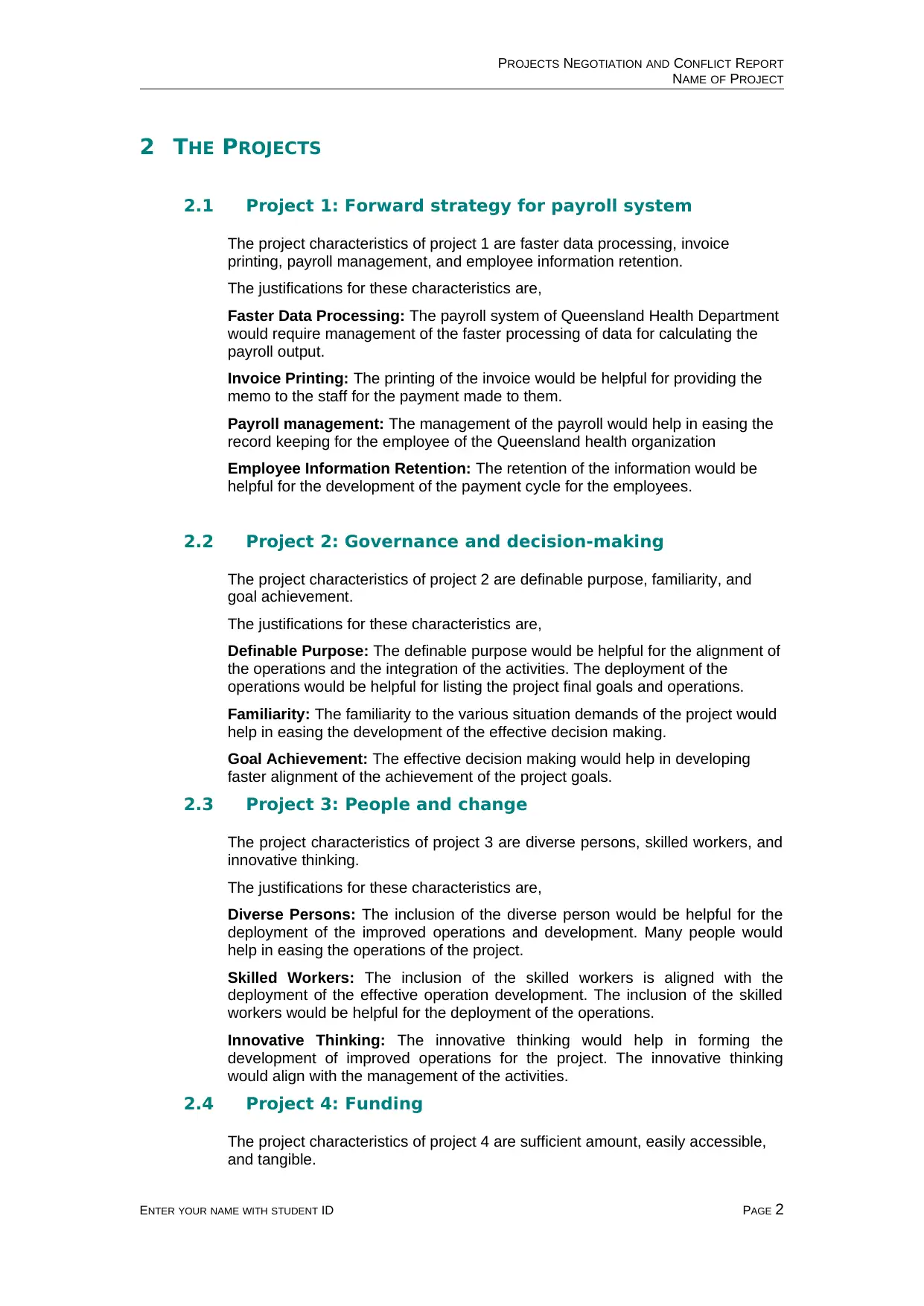
PROJECTS NEGOTIATION AND CONFLICT REPORT
NAME OF PROJECT
2 THE PROJECTS
2.1 Project 1: Forward strategy for payroll system
The project characteristics of project 1 are faster data processing, invoice
printing, payroll management, and employee information retention.
The justifications for these characteristics are,
Faster Data Processing: The payroll system of Queensland Health Department
would require management of the faster processing of data for calculating the
payroll output.
Invoice Printing: The printing of the invoice would be helpful for providing the
memo to the staff for the payment made to them.
Payroll management: The management of the payroll would help in easing the
record keeping for the employee of the Queensland health organization
Employee Information Retention: The retention of the information would be
helpful for the development of the payment cycle for the employees.
2.2 Project 2: Governance and decision-making
The project characteristics of project 2 are definable purpose, familiarity, and
goal achievement.
The justifications for these characteristics are,
Definable Purpose: The definable purpose would be helpful for the alignment of
the operations and the integration of the activities. The deployment of the
operations would be helpful for listing the project final goals and operations.
Familiarity: The familiarity to the various situation demands of the project would
help in easing the development of the effective decision making.
Goal Achievement: The effective decision making would help in developing
faster alignment of the achievement of the project goals.
2.3 Project 3: People and change
The project characteristics of project 3 are diverse persons, skilled workers, and
innovative thinking.
The justifications for these characteristics are,
Diverse Persons: The inclusion of the diverse person would be helpful for the
deployment of the improved operations and development. Many people would
help in easing the operations of the project.
Skilled Workers: The inclusion of the skilled workers is aligned with the
deployment of the effective operation development. The inclusion of the skilled
workers would be helpful for the deployment of the operations.
Innovative Thinking: The innovative thinking would help in forming the
development of improved operations for the project. The innovative thinking
would align with the management of the activities.
2.4 Project 4: Funding
The project characteristics of project 4 are sufficient amount, easily accessible,
and tangible.
ENTER YOUR NAME WITH STUDENT ID PAGE 2
NAME OF PROJECT
2 THE PROJECTS
2.1 Project 1: Forward strategy for payroll system
The project characteristics of project 1 are faster data processing, invoice
printing, payroll management, and employee information retention.
The justifications for these characteristics are,
Faster Data Processing: The payroll system of Queensland Health Department
would require management of the faster processing of data for calculating the
payroll output.
Invoice Printing: The printing of the invoice would be helpful for providing the
memo to the staff for the payment made to them.
Payroll management: The management of the payroll would help in easing the
record keeping for the employee of the Queensland health organization
Employee Information Retention: The retention of the information would be
helpful for the development of the payment cycle for the employees.
2.2 Project 2: Governance and decision-making
The project characteristics of project 2 are definable purpose, familiarity, and
goal achievement.
The justifications for these characteristics are,
Definable Purpose: The definable purpose would be helpful for the alignment of
the operations and the integration of the activities. The deployment of the
operations would be helpful for listing the project final goals and operations.
Familiarity: The familiarity to the various situation demands of the project would
help in easing the development of the effective decision making.
Goal Achievement: The effective decision making would help in developing
faster alignment of the achievement of the project goals.
2.3 Project 3: People and change
The project characteristics of project 3 are diverse persons, skilled workers, and
innovative thinking.
The justifications for these characteristics are,
Diverse Persons: The inclusion of the diverse person would be helpful for the
deployment of the improved operations and development. Many people would
help in easing the operations of the project.
Skilled Workers: The inclusion of the skilled workers is aligned with the
deployment of the effective operation development. The inclusion of the skilled
workers would be helpful for the deployment of the operations.
Innovative Thinking: The innovative thinking would help in forming the
development of improved operations for the project. The innovative thinking
would align with the management of the activities.
2.4 Project 4: Funding
The project characteristics of project 4 are sufficient amount, easily accessible,
and tangible.
ENTER YOUR NAME WITH STUDENT ID PAGE 2
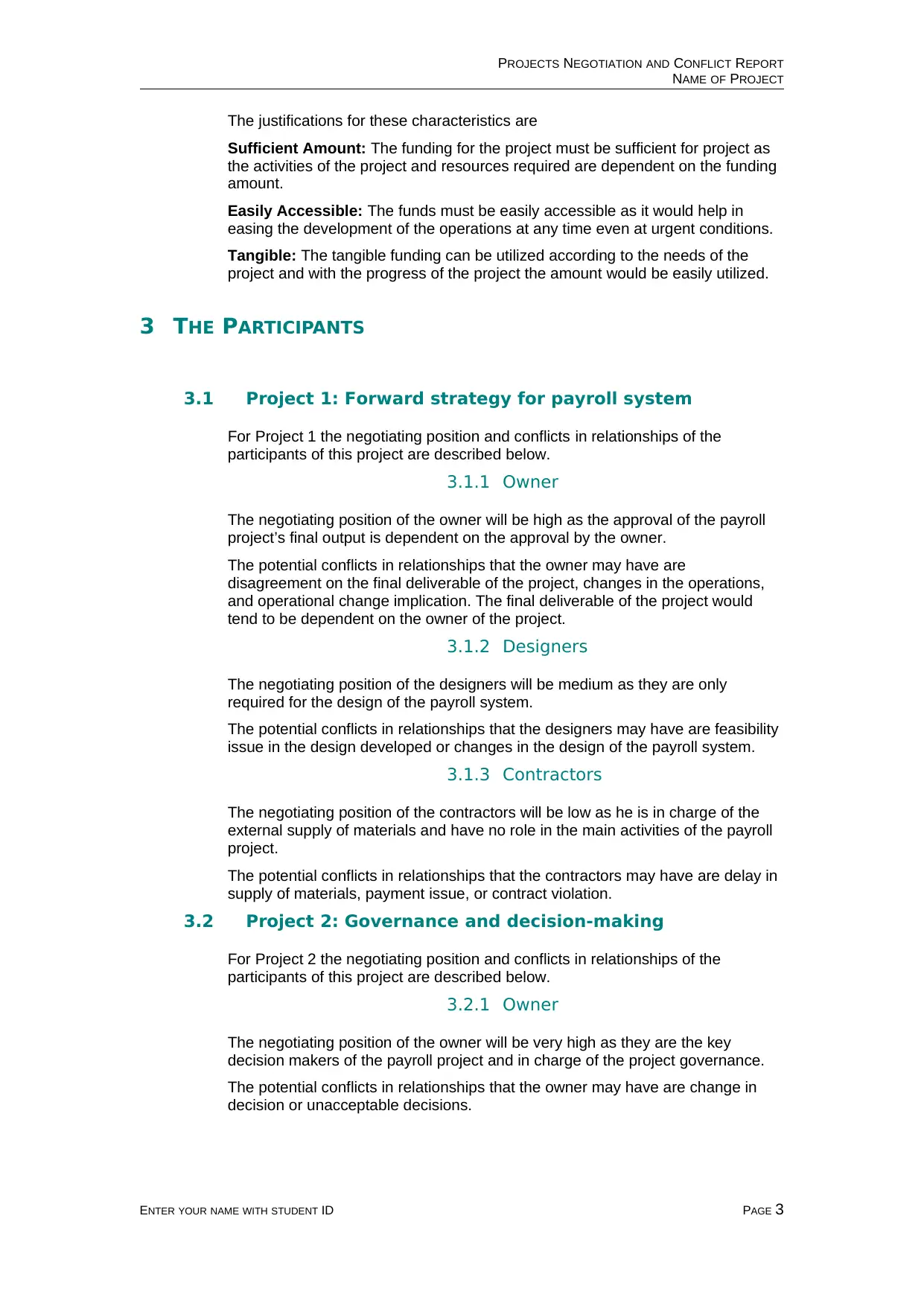
PROJECTS NEGOTIATION AND CONFLICT REPORT
NAME OF PROJECT
The justifications for these characteristics are
Sufficient Amount: The funding for the project must be sufficient for project as
the activities of the project and resources required are dependent on the funding
amount.
Easily Accessible: The funds must be easily accessible as it would help in
easing the development of the operations at any time even at urgent conditions.
Tangible: The tangible funding can be utilized according to the needs of the
project and with the progress of the project the amount would be easily utilized.
3 THE PARTICIPANTS
3.1 Project 1: Forward strategy for payroll system
For Project 1 the negotiating position and conflicts in relationships of the
participants of this project are described below.
3.1.1 Owner
The negotiating position of the owner will be high as the approval of the payroll
project’s final output is dependent on the approval by the owner.
The potential conflicts in relationships that the owner may have are
disagreement on the final deliverable of the project, changes in the operations,
and operational change implication. The final deliverable of the project would
tend to be dependent on the owner of the project.
3.1.2 Designers
The negotiating position of the designers will be medium as they are only
required for the design of the payroll system.
The potential conflicts in relationships that the designers may have are feasibility
issue in the design developed or changes in the design of the payroll system.
3.1.3 Contractors
The negotiating position of the contractors will be low as he is in charge of the
external supply of materials and have no role in the main activities of the payroll
project.
The potential conflicts in relationships that the contractors may have are delay in
supply of materials, payment issue, or contract violation.
3.2 Project 2: Governance and decision-making
For Project 2 the negotiating position and conflicts in relationships of the
participants of this project are described below.
3.2.1 Owner
The negotiating position of the owner will be very high as they are the key
decision makers of the payroll project and in charge of the project governance.
The potential conflicts in relationships that the owner may have are change in
decision or unacceptable decisions.
ENTER YOUR NAME WITH STUDENT ID PAGE 3
NAME OF PROJECT
The justifications for these characteristics are
Sufficient Amount: The funding for the project must be sufficient for project as
the activities of the project and resources required are dependent on the funding
amount.
Easily Accessible: The funds must be easily accessible as it would help in
easing the development of the operations at any time even at urgent conditions.
Tangible: The tangible funding can be utilized according to the needs of the
project and with the progress of the project the amount would be easily utilized.
3 THE PARTICIPANTS
3.1 Project 1: Forward strategy for payroll system
For Project 1 the negotiating position and conflicts in relationships of the
participants of this project are described below.
3.1.1 Owner
The negotiating position of the owner will be high as the approval of the payroll
project’s final output is dependent on the approval by the owner.
The potential conflicts in relationships that the owner may have are
disagreement on the final deliverable of the project, changes in the operations,
and operational change implication. The final deliverable of the project would
tend to be dependent on the owner of the project.
3.1.2 Designers
The negotiating position of the designers will be medium as they are only
required for the design of the payroll system.
The potential conflicts in relationships that the designers may have are feasibility
issue in the design developed or changes in the design of the payroll system.
3.1.3 Contractors
The negotiating position of the contractors will be low as he is in charge of the
external supply of materials and have no role in the main activities of the payroll
project.
The potential conflicts in relationships that the contractors may have are delay in
supply of materials, payment issue, or contract violation.
3.2 Project 2: Governance and decision-making
For Project 2 the negotiating position and conflicts in relationships of the
participants of this project are described below.
3.2.1 Owner
The negotiating position of the owner will be very high as they are the key
decision makers of the payroll project and in charge of the project governance.
The potential conflicts in relationships that the owner may have are change in
decision or unacceptable decisions.
ENTER YOUR NAME WITH STUDENT ID PAGE 3
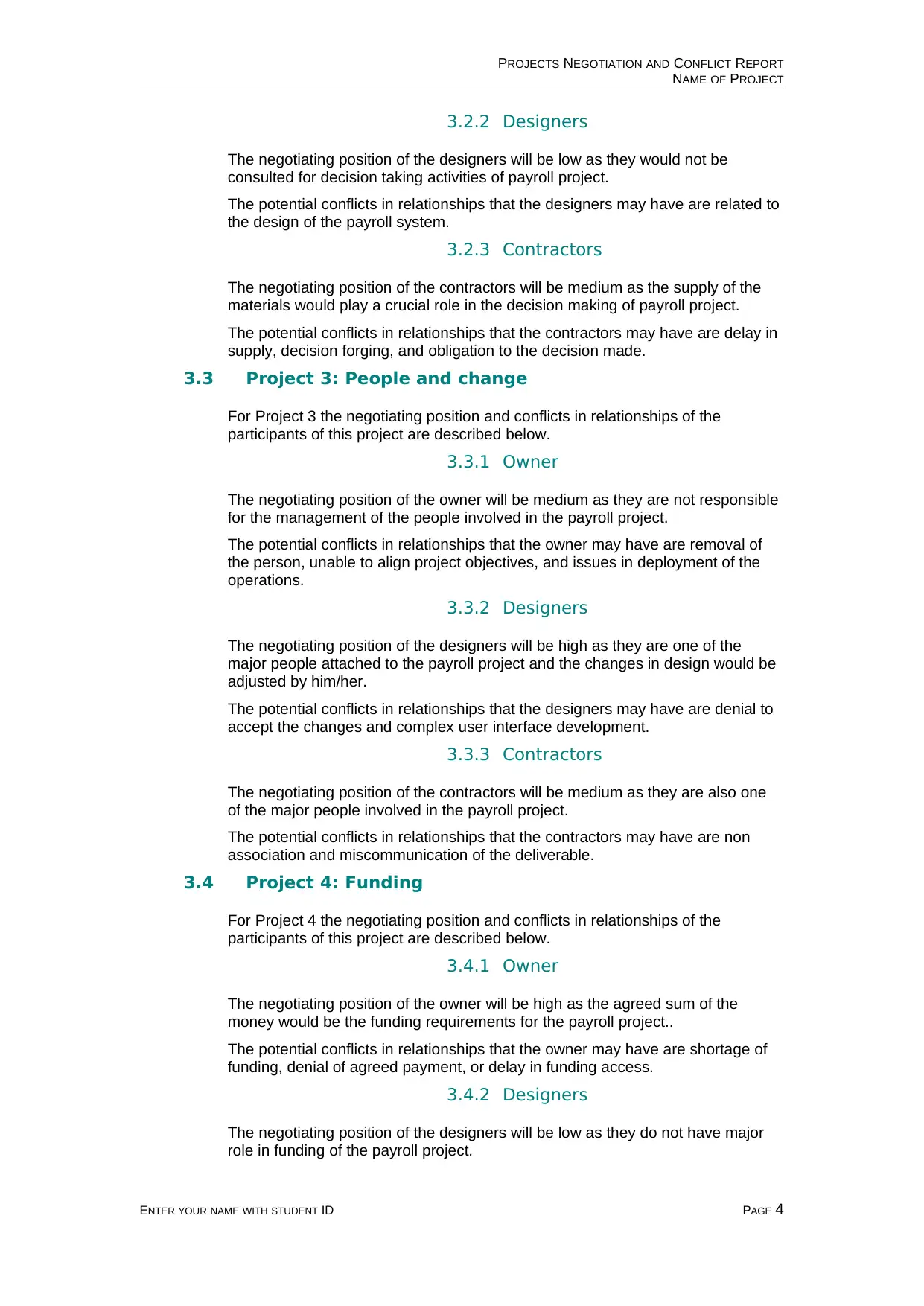
PROJECTS NEGOTIATION AND CONFLICT REPORT
NAME OF PROJECT
3.2.2 Designers
The negotiating position of the designers will be low as they would not be
consulted for decision taking activities of payroll project.
The potential conflicts in relationships that the designers may have are related to
the design of the payroll system.
3.2.3 Contractors
The negotiating position of the contractors will be medium as the supply of the
materials would play a crucial role in the decision making of payroll project.
The potential conflicts in relationships that the contractors may have are delay in
supply, decision forging, and obligation to the decision made.
3.3 Project 3: People and change
For Project 3 the negotiating position and conflicts in relationships of the
participants of this project are described below.
3.3.1 Owner
The negotiating position of the owner will be medium as they are not responsible
for the management of the people involved in the payroll project.
The potential conflicts in relationships that the owner may have are removal of
the person, unable to align project objectives, and issues in deployment of the
operations.
3.3.2 Designers
The negotiating position of the designers will be high as they are one of the
major people attached to the payroll project and the changes in design would be
adjusted by him/her.
The potential conflicts in relationships that the designers may have are denial to
accept the changes and complex user interface development.
3.3.3 Contractors
The negotiating position of the contractors will be medium as they are also one
of the major people involved in the payroll project.
The potential conflicts in relationships that the contractors may have are non
association and miscommunication of the deliverable.
3.4 Project 4: Funding
For Project 4 the negotiating position and conflicts in relationships of the
participants of this project are described below.
3.4.1 Owner
The negotiating position of the owner will be high as the agreed sum of the
money would be the funding requirements for the payroll project..
The potential conflicts in relationships that the owner may have are shortage of
funding, denial of agreed payment, or delay in funding access.
3.4.2 Designers
The negotiating position of the designers will be low as they do not have major
role in funding of the payroll project.
ENTER YOUR NAME WITH STUDENT ID PAGE 4
NAME OF PROJECT
3.2.2 Designers
The negotiating position of the designers will be low as they would not be
consulted for decision taking activities of payroll project.
The potential conflicts in relationships that the designers may have are related to
the design of the payroll system.
3.2.3 Contractors
The negotiating position of the contractors will be medium as the supply of the
materials would play a crucial role in the decision making of payroll project.
The potential conflicts in relationships that the contractors may have are delay in
supply, decision forging, and obligation to the decision made.
3.3 Project 3: People and change
For Project 3 the negotiating position and conflicts in relationships of the
participants of this project are described below.
3.3.1 Owner
The negotiating position of the owner will be medium as they are not responsible
for the management of the people involved in the payroll project.
The potential conflicts in relationships that the owner may have are removal of
the person, unable to align project objectives, and issues in deployment of the
operations.
3.3.2 Designers
The negotiating position of the designers will be high as they are one of the
major people attached to the payroll project and the changes in design would be
adjusted by him/her.
The potential conflicts in relationships that the designers may have are denial to
accept the changes and complex user interface development.
3.3.3 Contractors
The negotiating position of the contractors will be medium as they are also one
of the major people involved in the payroll project.
The potential conflicts in relationships that the contractors may have are non
association and miscommunication of the deliverable.
3.4 Project 4: Funding
For Project 4 the negotiating position and conflicts in relationships of the
participants of this project are described below.
3.4.1 Owner
The negotiating position of the owner will be high as the agreed sum of the
money would be the funding requirements for the payroll project..
The potential conflicts in relationships that the owner may have are shortage of
funding, denial of agreed payment, or delay in funding access.
3.4.2 Designers
The negotiating position of the designers will be low as they do not have major
role in funding of the payroll project.
ENTER YOUR NAME WITH STUDENT ID PAGE 4
Secure Best Marks with AI Grader
Need help grading? Try our AI Grader for instant feedback on your assignments.
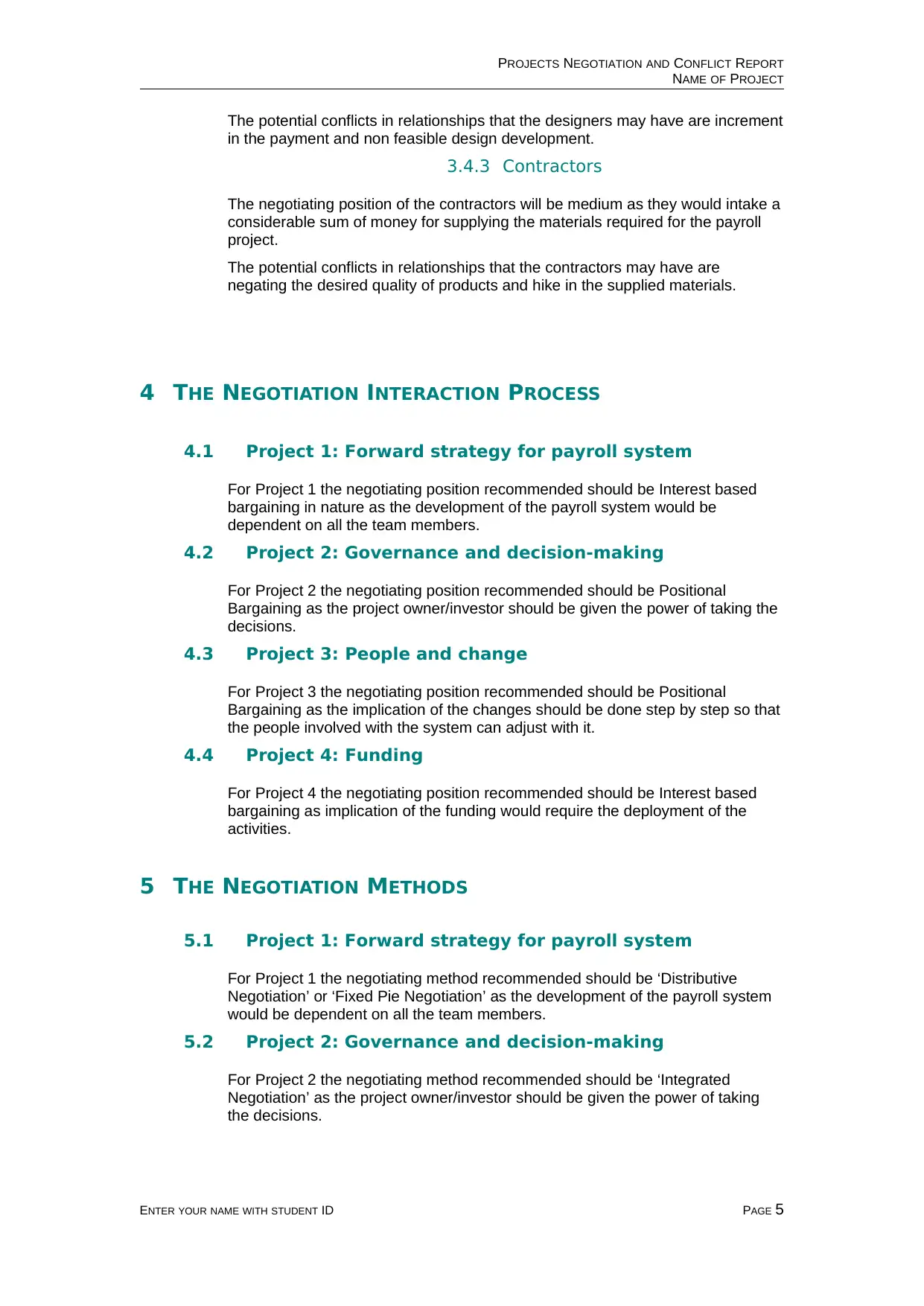
PROJECTS NEGOTIATION AND CONFLICT REPORT
NAME OF PROJECT
The potential conflicts in relationships that the designers may have are increment
in the payment and non feasible design development.
3.4.3 Contractors
The negotiating position of the contractors will be medium as they would intake a
considerable sum of money for supplying the materials required for the payroll
project.
The potential conflicts in relationships that the contractors may have are
negating the desired quality of products and hike in the supplied materials.
4 THE NEGOTIATION INTERACTION PROCESS
4.1 Project 1: Forward strategy for payroll system
For Project 1 the negotiating position recommended should be Interest based
bargaining in nature as the development of the payroll system would be
dependent on all the team members.
4.2 Project 2: Governance and decision-making
For Project 2 the negotiating position recommended should be Positional
Bargaining as the project owner/investor should be given the power of taking the
decisions.
4.3 Project 3: People and change
For Project 3 the negotiating position recommended should be Positional
Bargaining as the implication of the changes should be done step by step so that
the people involved with the system can adjust with it.
4.4 Project 4: Funding
For Project 4 the negotiating position recommended should be Interest based
bargaining as implication of the funding would require the deployment of the
activities.
5 THE NEGOTIATION METHODS
5.1 Project 1: Forward strategy for payroll system
For Project 1 the negotiating method recommended should be ‘Distributive
Negotiation’ or ‘Fixed Pie Negotiation’ as the development of the payroll system
would be dependent on all the team members.
5.2 Project 2: Governance and decision-making
For Project 2 the negotiating method recommended should be ‘Integrated
Negotiation’ as the project owner/investor should be given the power of taking
the decisions.
ENTER YOUR NAME WITH STUDENT ID PAGE 5
NAME OF PROJECT
The potential conflicts in relationships that the designers may have are increment
in the payment and non feasible design development.
3.4.3 Contractors
The negotiating position of the contractors will be medium as they would intake a
considerable sum of money for supplying the materials required for the payroll
project.
The potential conflicts in relationships that the contractors may have are
negating the desired quality of products and hike in the supplied materials.
4 THE NEGOTIATION INTERACTION PROCESS
4.1 Project 1: Forward strategy for payroll system
For Project 1 the negotiating position recommended should be Interest based
bargaining in nature as the development of the payroll system would be
dependent on all the team members.
4.2 Project 2: Governance and decision-making
For Project 2 the negotiating position recommended should be Positional
Bargaining as the project owner/investor should be given the power of taking the
decisions.
4.3 Project 3: People and change
For Project 3 the negotiating position recommended should be Positional
Bargaining as the implication of the changes should be done step by step so that
the people involved with the system can adjust with it.
4.4 Project 4: Funding
For Project 4 the negotiating position recommended should be Interest based
bargaining as implication of the funding would require the deployment of the
activities.
5 THE NEGOTIATION METHODS
5.1 Project 1: Forward strategy for payroll system
For Project 1 the negotiating method recommended should be ‘Distributive
Negotiation’ or ‘Fixed Pie Negotiation’ as the development of the payroll system
would be dependent on all the team members.
5.2 Project 2: Governance and decision-making
For Project 2 the negotiating method recommended should be ‘Integrated
Negotiation’ as the project owner/investor should be given the power of taking
the decisions.
ENTER YOUR NAME WITH STUDENT ID PAGE 5
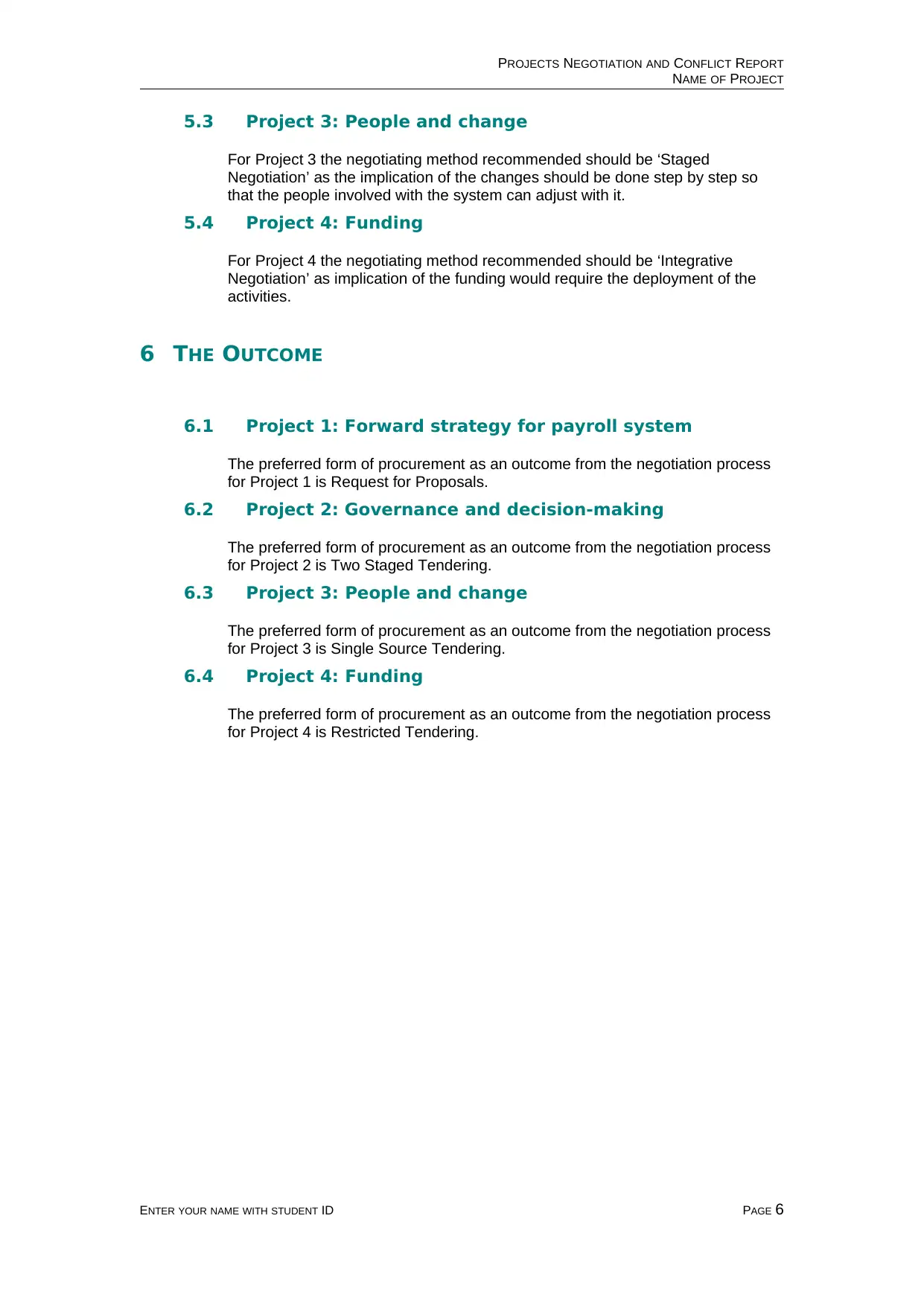
PROJECTS NEGOTIATION AND CONFLICT REPORT
NAME OF PROJECT
5.3 Project 3: People and change
For Project 3 the negotiating method recommended should be ‘Staged
Negotiation’ as the implication of the changes should be done step by step so
that the people involved with the system can adjust with it.
5.4 Project 4: Funding
For Project 4 the negotiating method recommended should be ‘Integrative
Negotiation’ as implication of the funding would require the deployment of the
activities.
6 THE OUTCOME
6.1 Project 1: Forward strategy for payroll system
The preferred form of procurement as an outcome from the negotiation process
for Project 1 is Request for Proposals.
6.2 Project 2: Governance and decision-making
The preferred form of procurement as an outcome from the negotiation process
for Project 2 is Two Staged Tendering.
6.3 Project 3: People and change
The preferred form of procurement as an outcome from the negotiation process
for Project 3 is Single Source Tendering.
6.4 Project 4: Funding
The preferred form of procurement as an outcome from the negotiation process
for Project 4 is Restricted Tendering.
ENTER YOUR NAME WITH STUDENT ID PAGE 6
NAME OF PROJECT
5.3 Project 3: People and change
For Project 3 the negotiating method recommended should be ‘Staged
Negotiation’ as the implication of the changes should be done step by step so
that the people involved with the system can adjust with it.
5.4 Project 4: Funding
For Project 4 the negotiating method recommended should be ‘Integrative
Negotiation’ as implication of the funding would require the deployment of the
activities.
6 THE OUTCOME
6.1 Project 1: Forward strategy for payroll system
The preferred form of procurement as an outcome from the negotiation process
for Project 1 is Request for Proposals.
6.2 Project 2: Governance and decision-making
The preferred form of procurement as an outcome from the negotiation process
for Project 2 is Two Staged Tendering.
6.3 Project 3: People and change
The preferred form of procurement as an outcome from the negotiation process
for Project 3 is Single Source Tendering.
6.4 Project 4: Funding
The preferred form of procurement as an outcome from the negotiation process
for Project 4 is Restricted Tendering.
ENTER YOUR NAME WITH STUDENT ID PAGE 6
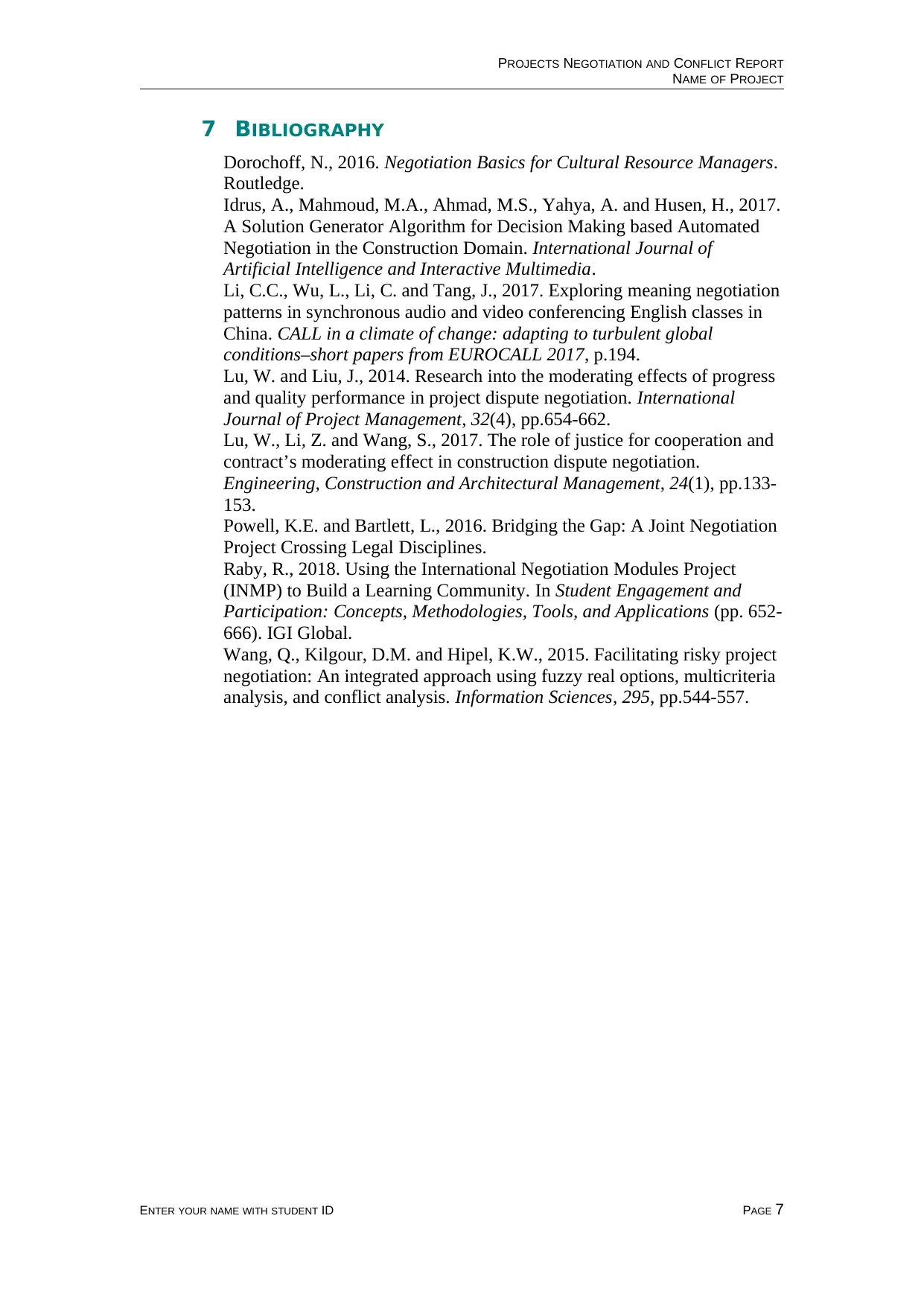
PROJECTS NEGOTIATION AND CONFLICT REPORT
NAME OF PROJECT
7 BIBLIOGRAPHY
Dorochoff, N., 2016. Negotiation Basics for Cultural Resource Managers.
Routledge.
Idrus, A., Mahmoud, M.A., Ahmad, M.S., Yahya, A. and Husen, H., 2017.
A Solution Generator Algorithm for Decision Making based Automated
Negotiation in the Construction Domain. International Journal of
Artificial Intelligence and Interactive Multimedia.
Li, C.C., Wu, L., Li, C. and Tang, J., 2017. Exploring meaning negotiation
patterns in synchronous audio and video conferencing English classes in
China. CALL in a climate of change: adapting to turbulent global
conditions–short papers from EUROCALL 2017, p.194.
Lu, W. and Liu, J., 2014. Research into the moderating effects of progress
and quality performance in project dispute negotiation. International
Journal of Project Management, 32(4), pp.654-662.
Lu, W., Li, Z. and Wang, S., 2017. The role of justice for cooperation and
contract’s moderating effect in construction dispute negotiation.
Engineering, Construction and Architectural Management, 24(1), pp.133-
153.
Powell, K.E. and Bartlett, L., 2016. Bridging the Gap: A Joint Negotiation
Project Crossing Legal Disciplines.
Raby, R., 2018. Using the International Negotiation Modules Project
(INMP) to Build a Learning Community. In Student Engagement and
Participation: Concepts, Methodologies, Tools, and Applications (pp. 652-
666). IGI Global.
Wang, Q., Kilgour, D.M. and Hipel, K.W., 2015. Facilitating risky project
negotiation: An integrated approach using fuzzy real options, multicriteria
analysis, and conflict analysis. Information Sciences, 295, pp.544-557.
ENTER YOUR NAME WITH STUDENT ID PAGE 7
NAME OF PROJECT
7 BIBLIOGRAPHY
Dorochoff, N., 2016. Negotiation Basics for Cultural Resource Managers.
Routledge.
Idrus, A., Mahmoud, M.A., Ahmad, M.S., Yahya, A. and Husen, H., 2017.
A Solution Generator Algorithm for Decision Making based Automated
Negotiation in the Construction Domain. International Journal of
Artificial Intelligence and Interactive Multimedia.
Li, C.C., Wu, L., Li, C. and Tang, J., 2017. Exploring meaning negotiation
patterns in synchronous audio and video conferencing English classes in
China. CALL in a climate of change: adapting to turbulent global
conditions–short papers from EUROCALL 2017, p.194.
Lu, W. and Liu, J., 2014. Research into the moderating effects of progress
and quality performance in project dispute negotiation. International
Journal of Project Management, 32(4), pp.654-662.
Lu, W., Li, Z. and Wang, S., 2017. The role of justice for cooperation and
contract’s moderating effect in construction dispute negotiation.
Engineering, Construction and Architectural Management, 24(1), pp.133-
153.
Powell, K.E. and Bartlett, L., 2016. Bridging the Gap: A Joint Negotiation
Project Crossing Legal Disciplines.
Raby, R., 2018. Using the International Negotiation Modules Project
(INMP) to Build a Learning Community. In Student Engagement and
Participation: Concepts, Methodologies, Tools, and Applications (pp. 652-
666). IGI Global.
Wang, Q., Kilgour, D.M. and Hipel, K.W., 2015. Facilitating risky project
negotiation: An integrated approach using fuzzy real options, multicriteria
analysis, and conflict analysis. Information Sciences, 295, pp.544-557.
ENTER YOUR NAME WITH STUDENT ID PAGE 7
1 out of 7
Related Documents
Your All-in-One AI-Powered Toolkit for Academic Success.
+13062052269
info@desklib.com
Available 24*7 on WhatsApp / Email
![[object Object]](/_next/static/media/star-bottom.7253800d.svg)
Unlock your academic potential
© 2024 | Zucol Services PVT LTD | All rights reserved.